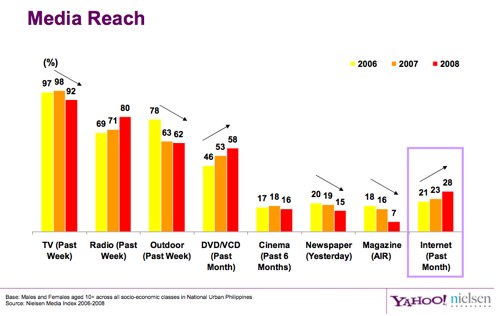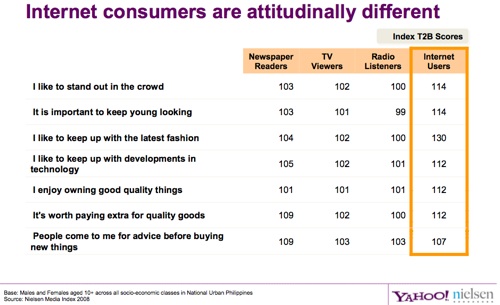
Jay Bautista, Nielsen Company executive director for media
If there is anything that excites me more is research findings or trends related to my interests like the internet. I was holed up at the Emergency Room of the Medical City early this morning because my daughter had to be given anti-rabies shots because her pet cat bit her hand without provocation. My daughter, knowing how I love research studies told me to go ahead to the Yahoo! & Nielsen Release of the First-Ever Internet Habits Study for the Philippines but I got there after the presentation of the study. Good thing I was able to catch up with Jay Bautista about some aspects of the study.
The results of this study are quite revealing. It is very relevant to marketers and media planners as it provides insights into urban Filipino internet user habits.
The research was based on personal face-to-face interviews using two-part structured questionaires in 22 major cities including Metro Manila with a sample size of 1200, males and females aged 10+ years old across all socio-economic classes who have used the internet in the past month. A multi-stage probability sampling approach was used. Survey was conducted from October to November 2008.
What are the significant highlights of the study?
1. More Filipinos, especially the younger population, are favoring the Internet more than television and print.

TV viewership declined from 98 percent in 2007 to 92 percent in 2008, out of 1,200 people sampled. Readership of newspapers also showed a decline from 19 to 15 percent between 2007 and 2008. Magazine readership also went down from 16 percent in 2007 to just seven percent in 2008.
Internet usage increased from 23 percent in 2007 to 28 percent in 2008.
2. 28% of Filipinos in National Urban Philippines have accessed the internet in the past month. 5% access the internet every day.
That is an estimated 20 million internet users up by 5% from the last year’s estimate.
3. Internet use is not restricted to the big cities like Metro Manila. Other cities are experiencing internet growth. For example, 35% of Filipinos in Cagayan de Oro have accessed the internet in the past month.
4. Filipino internet users are more likely to be opinion leaders and early adopters compared to traditional media consumers. They are likely to be individualistic, trend conscious, willing to pay for quality products and tech-enthusiasts. They also look for advice online before buying new things.

5. Internet cafes are an important access point. 71% have accessed the internet from internet cafes in the past 3 months. 47% of all internet time are spent in internet cafes.
6. Social networking is a key online activity.
- 51 % claimed to have visited a social networking site in the past month.
- 1 in 3 Filipino internet users have a blog
7. Online transactions or commerce remain low. Only 3% of internet users conduct online banking activities or make online purchases.
8. Filipino internet users are likely to be below 29 years old, single and are better educated.
9. Internet usage is particularly higher amongst the younger segment. 50% of those below 20 years old have accessed the internet in the past month, with a breakdown of the following:
(% past internet access)
10-19 years old – 50 %
20-29 years old- 41%
30-39 years old- 19%
40-49 years old – 12%
50 + years- 3%
Looks like my peers are just a mere 3% of the internet user population.
10. Email (63%), Instant Messaging (63%) and Search (58%) are the most common online activities for Filipino internet users followed by searches (58%), playing games online (53%), social network site (51%), download/upload of digital photos (42%), internet radio (28%), down-/upload music files (25%), read news online (24%), internet SMS (23%), online banking (3%), purchased products online (3%).
Yahoo! is the dominant web-based email, instant messaging and search service in the Philippines.
11. For bloggers, here are relevant statistics.
- 42% read blogs
- 32% worked on a personal blog
Jay Bautista told me that 90% of bloggers are using friendster. Not surprising since Friendster is the leading social network in the Philippines.
The findings shows that there are probably 6,400,000 bloggers (32% of estimated 20 million internet users) and 90% of which are bloggers using Friendster’s blog making that 640,000 bloggers using Multiply, Livejournal, hosted accounts, blogger, or wordpress.
The implication of the study is that marketers and media planners in the Philippines can re-examine their advertising strategies and utilize the internet as an effective way to reach and engage target consumers. With an estimated 20 million internet users, the Philippines will see more users going online to communicate with family and friends, to engage in entertainment, and to obtain information as the internet becomes increasingly accessible around the country. Businesses will need to keep up and understand the new opportunities the internet medium and their online consumers bring. Yahoo!, on the other hand, views the survey results as a way to convince advertisers to widen their marketing strategies to an online platform.
With a generation of young Filipinos growing up as digital natives, understanding their media habits is critical to understanding of the future.
Some key highlights of the study below
Yahoo Nielsen Internet Habits Study for the Philippines
Related Blogs & News
Internet use in RP expanding to lower income groups, ABS CBN
Declining Filipino TV, print consumption Inquirer.net
Video: Study shows changing media habits of Filipinos, Inquirer.net

imho, Filipinos are more likely to be found in Friendster since its one of the oldest, most accepted social networking sites in the Philippines and maybe not for any other reason. 🙂 Another reason too why there is a low e-commerce acceptance is that many credit card validators do not accept purchases coming from our country.
At any rate, nice study from Nielsen. Good to know some are still interested in the facts involving Filipino community.
Thanks for this post, Noemi. Very revealing indeed.!
DJBs last blog post..A Keeper From Baycas
wonder what the implications are for the 2010 elections. haha
Very interesting read Ms. Noemi. I am quite surprised that the highest percentage of Internet users are below 20 years old. Akala ko yung 20-29 age bracket, this explains why ecommerce is not picking up also, because users below 20 years old are mostly students.
Badets last blog post..Playboy Philippines sponsors Bloggers Night Out at the Source Bar
Statistics around the world have consistently showed that the highest internet users belong to below 20 years old.
Finally! Some meaningful data on Filipinos internet behavior. Thanks for sharing!
Online transactions or commerce remain low.Definitely correlated with the number of Filipino internet users who even have credit cards in the first place. But practically everyone has G-cash or Smart Money or can easily find somewhere to send a transfer. Or they’re too afraid of “getting hacked” online whereas it’s relatively safer to buy online than to pass their card to a waiter or gas attendant. Odd, noh?
looks like traditional mediums (of communication) has to reinvent themselves to not lose it’s market… also shows how PINOYs are diving heavily on the internet which is good…
great stuff!! thanks for sharing!
lol…..that’s not new for us…dahil tayong mga pinoy sunod sa uso…lol
TECHNO BLOG
allans last blog post..Mp3 player: iPod Touch will have Bluetooth
tnx for sharing noemi. count me in your peer group on this. hope we can raise our group’s percentage. lol.
let’s increase the internet users our age group
yes. good luck to the golden age group!:)
Pingback: tonyocruz.com » Studies and statistics on the internet in the Philippines
hi 🙂 would you know how i can get a copy of the whole report?
Contact Nielsen
Address: Ortigas Ave. Columbia Tower Mandaluyong City Metro Manila Philippines
blank
AC Nielsen (Philippines) Inc. PRIMARY PHONE (02) 727-3701
First ever? I seem to remember Nielsen publishing the same sort of report back in 2004 in celebration of the 10th year of Philippine Internet.
Martin Gomezs last blog post..Think
Pingback: The State of the Filipino Nation | Filipino Voices